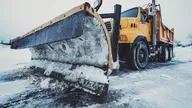It Is Ice to See You
Posted:
How Seasonal Connections Are Affected by Climate Change
Origin Story: What Is Climate Modelling?
Climatologists are scientists who study climate change. Climate modelers are climatologists who want to learn what could happen to the climate on Earth in the future. They use supercomputers to analyse data: information on temperature, humidity, precipitation and more. By using math, coding, physics, and an understanding of Earth’s processes, they build working models of Earth in computer software. They then run simulations and experiments to see how climate will change and make projections based upon their gathered information.
Dr. Yukari Hori is one such climatologist from the University of Toronto who has been working with remote Northern Ontario communities. Community members requested help to better understand how a changing climate has been affecting a major lifeline for them in winter: ice roads.
Winter Ice Roads – Where the Rubber Hits the Ice
For most of us, we may not give much thought to how our household goods, building supplies, vehicles, fuel, and other necessities come into our cities and towns. We do know that ‘stuff’ probably travelled by transport truck or rail. However, many northern, remote, Indigenous communities rely on seasonal corridors or ice roads to get their essential goods. Otherwise, these necessities would have to be flown in on planes or helicopters, as there is no railway or all-season road infrastructure. Due to the high cost of aviation fuel, airport maintenance fees, high costs of aircraft and their personnel, shipping costs can be up to twenty times more expensive than land. For example, the cost to send something by road could be one hundred dollars. To ship by air, the cost could be as much as two thousand dollars!
The construction and maintenance of winter road systems requires a colder climate. Climate factors such as surface air temperature, precipitation, snowfall, and wind all directly affect the winter road systems. These vast road connections will run over land, rivers, lakes, and bays. The ice that forms in lakes and rivers must be thick enough to hold vehicles that can weigh up to twenty tonnes, so ice thickness is a major factor to the reliability of the winter roads as well as when they can be opened and closed. Over the short life span of each seasonal winter road, it must be maintained and observed for accumulated snow, soft spots on the ice, and uneven ground and land-water transition points. Before and during the season, sections have to be repaired, levelled, or flattened, and observed for ice thickness.
In recent years, climatologists like Dr. Hori have been using climate modelling to assess the impacts of climate change on the longevity of winter roads in the next century. By using historical climate data from various weather stations in a particular area and analyzing it using computer and statistical software, scientists are able to simulate and analyze patterns and develop climate projections. A projection is similar to a prediction or where they determine what should happen under certain situations. They are using the modelling to project future ice road seasons and whether climate conditions would be favourable or not.
One example they looked at is in Ontario’s Far North (OFN), from the western Canadian Shield to the Hudson Bay Lowlands, where warming trends have been seen in the past three decades, particularly during November. This time period is important as this is when lower seasonal temperatures would allow for the preparation of the winter roads where land portions can be readied and constructed while ice forms on the water sections. Some areas of OFN have modelled projections where climate conditions would be unfavourable for winter road construction by the middle of the 21st century , and in other areas, climate conditions would be unfavourable by the end of the century. As climate change continues to affect the preparation period, and so the maintenance and longevity of winter roads, then these communities will continue to struggle to maintain their way of life.
Winter roads in the northern regions of Canada are a crucial seasonal lifeline, to transport essential goods and services while also providing connections for social and cultural gatherings and meetings between communities. Following the modelling and projections, there is definite uncertainty regarding the possibility and durability of the winter roads. Long-term planning, adaptation strategies and coordination of people and ideas are needed at community and government levels.
Climate Action
The are many things you can do to work towards Climate Action. Participate in local activities that help the community such as spring clean-up, climate awareness campaigns, and Earth Day events. You can do things to help the environment by using less plastic, recycling when possible, conserving water, and using green methods of transport like riding your bike in the summer.
To develop a better understanding of northern ways of life and its hardships, it is important to form connections with Indigenous communities and learn their perspectives. Make the time and speak with Indigenous Elders, leaders, and youth. Many Indigenous people who live in larger urban centres may have connections to northern communities as well and may help you with your learning journey.
Meet Our Local Science Hero:

Dr. Yukari Hori
How did your interest in winter ice roads and climate change come about?
When I was a Ph.D. student at University of Toronto, one of my supervisors who used to live in Fort Albany told me that local people are concerned about the impacts of climate change on their winter roads. Later, I found that many fly-in First Nations communities in Northern Ontario rely on the winter (ice) road networks. I believe that understanding the impacts of climate change on winter (ice) roads is an important area of research that would help to adapt the changes or mitigate the risks for the northern communities.
What is the best part of being a scientist?
I think we have an opportunity to discover new knowledge, and we have a chance to make a significant contribution to our society by our discoveries.
If you could share one call to action with Canadian youth, what would you say?
I would like to share this old proverb: “Where there is a will, there is a way.”
THIS ARTICLE IS COURTESY OF GENACTION.
Credit
This Science Spotlight was written based on Hori, Yukari, Vincent Y.S. Cheng, William A. Gough, Jerry Y. Jien, and Leonard J.S. Tsuji. 2018. “Implications of projected climate change on winter road systems in Ontario’s Far North, Canada.” Climatic Change, 148: 109-122. https://doi.org/10.1007/s10584-018-2178-2
Related Articles


Food Chain Reactions
How Climate Change is Impacting Canada's Lakes


It Is Ice to See You
How Seasonal Connections Are Affected by Climate Change


Getting to the Core of Climate Change
A Look at How Refrigerants Are Affecting Our Environment through Ice Cores
Related Articles


Food Chain Reactions
How Climate Change is Impacting Canada's Lakes


It Is Ice to See You
How Seasonal Connections Are Affected by Climate Change


Getting to the Core of Climate Change
A Look at How Refrigerants Are Affecting Our Environment through Ice Cores





